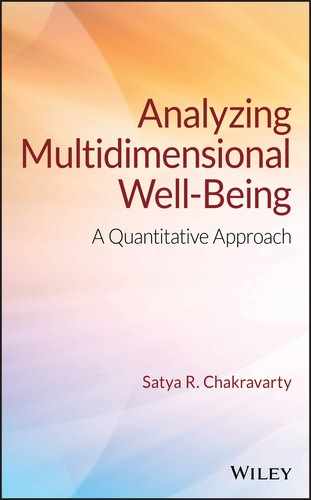Preface
Since often an income distribution of a society fails to include heterogeneity in the distributions of one or more other dimensions of well-being of a population such as health, education, and housing etc.; income's unsuitability as the solitary attribute of well-being is clearly understandable. In fact, it has now become well-recognized that human prosperity should be treated as a multidimensional aspect. Consequently, there has been a spur among researchers to work on multidimensional economic well-being.
There has been significant development in the areas of multivariate welfare, inequality, and poverty in the recent past, and hence, I felt the need to take the opportunity to delve deeper into the core values of the stated concepts. What is presented in this book is a theory of multidimensional welfare, inequality, and poverty in an axiomatic architecture. The aim is to clarify how we can proceed to the evaluation of the three issues and address the questions of enhancing welfare and reducing inequality and poverty.
The monograph casts ample light on the concepts, and I believe such an elusive discussion will intrigue students, teachers, researchers, and practitioners in the area. Substantive coverage of ongoing and advanced topics and their inquisitive, eloquent, accurate bestowal make the treatise theoretically and methodologically quite concurrent and comprehensive and highly susceptible to the practical problems of recent concern.
Since the use of simple one-dimensional indices for reckoning welfare and inequality of a population or the comparison of similar measurements pertaining to another population is an improper analysis, Chapter 1 looks to assess how well off a society can be in terms of individual achievements in different dimensions. The purpose of Chapter 2 is to review the alternative approaches to the evaluation of multidimensional inequality. Picking up from the note that welfare of a population needs an appraisal from a multivariate perspective, poverty can be regarded as a demonstration of inadequacy of achievements in different dimensions of wellbeing. Hence, Chapters 3 attempts to present an analytical discussion on the axiomatic approach to the measurement of multidimensional poverty.
There might arise a problem of gathering sufficient information on achievements in different dimensions of well-being, thereby raising questions at the poverty status of an individual. To tackle this ambiguity, fuzzy set theory can be employed to handle the vagueness resulting from obscurity. This fuzzy set approach to multidimensional poverty judgment has been addressed in Chapter 4.
In the persuasive investigations made in Chapters 3 and 4, which are based on the individual multidimensional achievements as inputs in a single period, time span of poverty is ignored. Nevertheless, there are plentiful reasons to believe that poverty is not a timeless concept. It can be regarded as a concept that endures changes over time. Furthermore, it would be wrong to expect that the transformations of income and nonincome dimensions of life will be the same across time. In view of this, Chapter 5 throws light on the different approaches that scrutinize lifetime poverty in a multidimensional framework.
Vulnerability and security risks always go hand in hand. In a wide sense, we can define vulnerability in terms of a system's disclosure and capability to cope sufficiently with discomfort. The study of vulnerability is hence quite significant because of the highly important follow-ups that may be generated as its implications for economic efficiency and long-term individual welfare. The purpose of Chapter 6 is deliberation of vulnerability as a multidimensional issue.
Finally, Chapter 7 reflects on the practicality of some composite and individualistic indices. A composite index is a summary measure, giving an all-inclusive picture of dimensional indices, associated with a dashboard. In the individualistic approach, individualwise indicators are derived initially by combining respective dimensional achievements and then by amalgamating the individual-level indicators.
At Paris School of Economics, I have had the excellent opportunity of working together with François Bourguignon, and I learned a great deal from talking with him. His influence has come not only through extensive discussions during the period but also through the use I made of the analytical framework in my later works that we developed. It is difficult for me to express my gratitude to him in words.
I have also worked jointly in this expanding area with Sabina Alkire, Mauricio Apablaza, Walter Bossert, Lidia Ceriani, Nachiketa Chattopadhyay, Conchita D'Ambrosio, Joseph Deutsch, Maria Ana Lugo, Diganta Mukherjee, Zoya Nissanov, Liu Qingbin, Ravi Ranade, Jacques Silber, Guanghua Wan, Gaston Yalonetzky, and Claudio Zoli. I have been very fortunate in having them as coauthors with whom I have had very illuminating conversations. I must acknowledge my extensive debt to them.
During the years, I have been privileged to receive comments and suggestions from Rolf Aaberge, Matthew D. Adler, Tony Atkinson, Valérie Berenger, Charles Blackorby, Kristof Bosmans, Florent Bresson, Koen Decancq, Stefan Dercon, David Donaldson, Jean-Yves Duclos, Indranil Dutta, Marc Fleurbaey, James E. Foster, Mridu P. Goswami, Carlos Gradin, Nanak C. Kakwani, Serge-Christophe Kolm, Casilda Lasso de la Vega, François Maniquet, Ajit Mishra, Patrick Moyes, Conan Mukherjee, Erwin Ooghe, Rupayan Pal, Eugenio Peluso, Iñaki Permanyer, Krishna Pendakur, Martin Ravallion, Ernesto Savaglio, Amartya K. Sen, John A. Weymark, and Buhong Zheng. I would like to acknowledge the benefit I received from the interactions with them.
I benefitted a lot from the critiques of my students at the Bocconi University, Milan, Italy; Indian Statistical Institute, Kolkata, India; and Indira Gandhi Institute of Development Research, Mumbai, India. I am grateful to them for the joys and benefits that I derived from interactive teaching. The figure files were generated by Nandish Chattopadhyay and Snigdha Chatterjee sat through some sessions of proof corrections. It is a pleasure for me to acknowledge the help I received from them.
I must note the help and advice I have received from my wife Sumita and son Ananyo, whose influence is reflected throughout the book.
The book has been dedicated to the memory of my eldest brother Keshab R. Chakravarty, a renowned cardiologist, who has started his after-life journey on 1 August 2016 at 7.43 pm.
Kolkata
Satya R. Chakravarty
